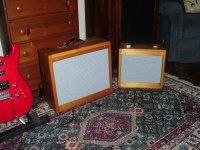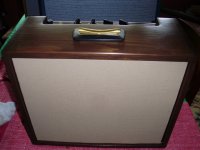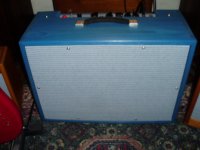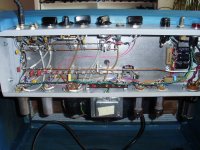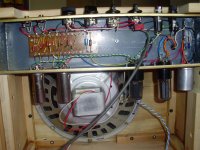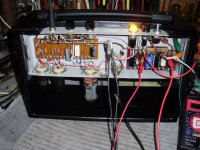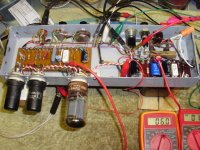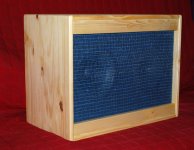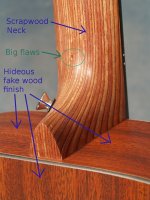I ended up with some orphan OPTs, and don't have use for mono audio amps,, so decided to try to build a few gituar amp clones...
Couple of Champs, 5F1, 5C1,,, Rickenbacker B9A,,, Supro 1624...
Couple of Champs, 5F1, 5C1,,, Rickenbacker B9A,,, Supro 1624...
Attachments
Nice looking builds! I especially like the turquoise one (Supro?). It's about time we had some colour in guitar amps! (Why should Orange have all the fun?)Couple of Champs, 5F1, 5C1,,, Rickenbacker B9A,,, Supro 1624...
-Gnobuddy
I did the same thing - built a Ampeg B15N amp out of parts (the original Ampeg B15N go for crazy money on ebay and reverb)...this is supposedly "The Amp" for Bass, but also a good guitar amp.
Looks like hell tho, but sounds quite nice. Next up is a 15 Watt Princeton Reverb.
Looks like hell tho, but sounds quite nice. Next up is a 15 Watt Princeton Reverb.
Yep,,, I helped a buddy rehab a 100 year old house,, got the pine boards for the cabs out of the attic,,, not even nailed down!!! liked the grain too much to put Tolex over it... Git amps are a good place to use single parts,,, Good winter projects also!
Building a Super Champ{6L6SE) type now,, that will fit into the 5F1 cab... Plywood black box is just to hold chassis/tubes in vertical position...
Building a Super Champ{6L6SE) type now,, that will fit into the 5F1 cab... Plywood black box is just to hold chassis/tubes in vertical position...
Attachments
Last edited:
It's quite shocking how much harder it is to find good wood today, than it was even a few decades ago....100 year old ...pine planks..looked at wood in big box type stores, really no comparison...
You would think fast-growing pine would be the one wood you could still find easily in North America, but the timber industry doesn't want to wait around long enough for even a pine tree to grow to its full majestic size, so they seem to cut it most of it down as soon as it's big enough to get low quality 4" or 6" wide planks from it. Those arrive at the "big box shop" already cupped, bowed, and twisted, and the wood has so much moisture in it that it they continue to change shape for months more.
For the last ten years or so, I noticed from the guitar magazine and Internet ads that all the guitar makers have been playing musical chairs with their fretboard woods. Every year or so there is yet another change to yet another even less attractive wood (or synthetic in some cases) as yet another type of tree becomes endangered or is brought to the edge of extinction.
Brazilian rosewood is gone for good. Indian rosewood seems to be right on the threshold of also being gone for good. Ebony? The beautiful black stuff is gone, now you can pay through the nose for ugly streaky-brown ebony if you can find it. A stream of other names have appeared and disappeared from the catalogues, including nato, ovangkol, pau ferro, purple heart, cocobolo, bubinga, wenge, bloodwood.
With the difficulty sourcing any kind of decent fretboard wood, some guitars and basses now use ground-up McDonald's takeout boxes (Richlite). Others use ordinary wood that's been burned in an oven to make it darker - but also more brittle and easily damaged. The marketing department then tries to pretend that the charred stuff is actually an advance in materials.
This tragic game of musical chairs is still ongoing. I just noticed today that Fender has started to advertise fretboards made of what they call "Indian laurel" on some of their Squier models. This is some sort of fig tree, and from the photos I've seen of "Indian laurel" fretboards, it is not a very attractive-looking wood.
I note that, during the last five years or so, IKEA Canada seems to have dropped all - or at least most - of the solid-pine items that used to be in their catalogue. The replacement products are either made of bamboo shreds glued together with plastic, sawdust glued together with plastic, or very fine sawdust glued together with plastic.
The attached photo shows a 2x8 guitar cab I made a few years ago from an IKEA solid-pine item of children's furniture they called a RAST. This cab is about the size of a Princeton Reverb, but a little deeper. You could buy a RAST cheaper than you could buy the same amount of pine planking, and for those without access to a table-saw, the RAST gave you a starting point that was already straight and square.
Yup, you guessed it. No more RAST. It's gone, along with all the other solid-pine items.
Perhaps in a few more years we'll have guitars made of bamboo shreds glued together with plastic, too?
-Gnobuddy
Attachments
Looks pretty nice!! What speakers did you put in it?The attached photo shows a 2x8 guitar cab I made a few years ago from an IKEA solid-pine item of children's furniture they called a RAST. -Gnobuddy
Totally agree,,, the new wood is much less dense then the salvaged stuff I build with,,, may have to glue a few planks together for width, but its solid and very stable... Even modern plywood is not as good as it used to be,,, nail it down when you buy it or it warps!!! I have a pair of Walnut speaker cabinets in my L/R that I built in HS shop class 1965, that are still straight and stable... so wood quality has decreased a lot in 50 years!!!
There is a lot of old wood around here, from rehab projects,,, may have to cut around nail holes and such, but for guitar size boxes, you can usually salvage enough to use,,,
There is a lot of old wood around here, from rehab projects,,, may have to cut around nail holes and such, but for guitar size boxes, you can usually salvage enough to use,,,
I think it's great to reuse and re-purpose salvaged wood especially for musical instruments and cabinetry. There's a guitar builder who turns old discarded skateboard decks into beautiful electric guitars. He mentioned in an article that the wood used in many skateboards is actually laminated hardrock maple.
I note that, during the last five years or so, IKEA Canada seems to have dropped all - or at least most - of the solid-pine items that used to be in their catalogue. The replacement products are either made of bamboo shreds glued together with plastic, sawdust glued together with plastic, or very fine sawdust glued together with plastic.
The attached photo shows a 2x8 guitar cab I made a few years ago from an IKEA solid-pine item of children's furniture they called a RAST.
I can get RAST here, but it's made short of bits of pine glued together. Not solid. But not MDF either.b
Thanks, knotty pine can be very pretty! The cab has grown rubber feet and a chrome handle (Home Depot drawer-pull!) since that photo was taken.Looks pretty nice!! What speakers did you put in it?
I've been experimenting with cheap speakers to see if I can find one that sounds good with e-guitar. The cab currently has one of these, except it was sold under a different brand name, and without the 70V line transformer, so it cost even less: 8" Ceiling Speaker with 70V Transformer for Background Music and Paging
The second speaker is one of these: GRS 8FR-8 Full-Range 8" Speaker Pioneer Type B20FU20-51FW
The first of the two sounds pretty good for many things, and I like it quite a bit. Bass is a bit lacking, and it wants some treble boost in the amp for the best sound.
The GRS is a bit of a dud as an electric guitar speaker. Bass is better, true, but mids and treble are lacking, and the speaker is less sensitive. It works okay for clean tones with some treble boost in the amp, but it's not a particularly enjoyable speaker to listen to.
All our beloved guitar speakers have most of the same physical characteristics as the primitive speakers from the era when amplifiers were low powered, and tweeters and crossover networks were too exotic for home use. The surround is made from (stiff) corrugated paper, the light paper cone is thin and floppy and breaks up at high frequencies, the voice coil is short for maximum sensitivity (and so overdrives easily).
Most halfway decent contemporary speakers are not made like that. But even now, cheap-n-nasty paging / P.A. speakers are still made the same way they made them in 1950 or 1960, except the largest size they come in now seems to be 8".
That's why I've been trying out these types of cheap paging / P.A. / full-range speakers. They have all the sonic characteristics we expect from our expensive guitar speakers, except for the big built-in treble boost from, say, 500 Hz to 3.5 kHz. Power handling is just a few watts, but that is actually a positive for me - you get some cone breakup at a watt or two of power, when SPLs are still somewhat reasonable.
(I think I may have just found a relatively cheap 8" speaker that has the built-in treble boost, too. More on that later, if it works out and is worth sharing.)
-Gnobuddy
In North America, glued together strips of wood are still called "solid", thanks to all those people with marketing degrees and flexible consciences.I can get RAST here, but it's made short of bits of pine glued together. Not solid. But not MDF either.
I first noticed this with acoustic guitar tops: clearly two pieces of wood glued together along the guitar's centreline, but everybody has been trained to call it a "solid spruce top".
(As an aside, I've owned and seen older steel-string and nylon-string acoustic guitars that used a single piece of solid wood for the entire top. There was a time when using one large piece of wood was cheaper than gluing together two book-matched pieces, so cheap guitars had a single, one-piece, solid wood top. Good luck finding trees big enough to yield one-piece wooden tops now!)
So yes, the IKEA RASTs I used to buy in the USA, and later Canada, were actually made from what used to be called "blockboard", which is now called "solid pine".
Apparently when the individual bits of wood become smaller than a grain of wheat, even the marketing types can no longer call it "solid pine", most likely for legal reasons. Then it becomes "chipboard" or "particle board" or "MDF" instead.
I think I've actually seen the term "solid bamboo" used for the stuff made from glued-together little chunks of bamboo, too!
-Gnobuddy
I have two guitars that have the Richlite fretboard, one of which is a Gibson Memphis. I really like how slick it is, count me in as one of the few that like it...but I read that Gibson was in a pinch having to be forced to use it - they got caught continuing to make fretboards on guitars with the now more illegal Rosewoods (CITES).New CITES Regulations For All Rosewood Species | Reverb News
I have one Craigslist-sourced Squier 5-string bass with a fretboard made from ground-up hamburger boxes. I didn't know that's what I was getting when I bought it - but I paid less than half the new price, the bass was flawless, and it had an expensive pro setup on it. So I don't have too much to complain about.I have two guitars that have the Richlite fretboard
After the fact, I'm okay with the feel of the plastic fretboard, and it doesn't seem to have any effect on the sound of the bass guitar. But I still have several concerns about it:
1) Premature wear: I can already see the plastic wearing away from contact with the metal strings in the areas between frets. It looks as though the windings on the strings are rasping away microscopic shreds of plastic as the strings move. I expect string vibrato (bass players do this too!) is one of the culprits. I've never noticed this type of visible wear on any of my guitars with wooden fretboards.
2) Thermal / humidity stability. You know how older Ovation guitars always have cracked tops, because the plastic bowl-backs don't move the same way wood does with humidity or temperature changes? Over time the plastic bowl tears the wooden top apart.
Well, I have the same concern about the plastic fretboard. Will it delaminate from the neck over time? Does it cause the neck to move more as humidity changes, because, unlike a wooden fretboard, it doesn't change dimensions with humidity?
3) Refret jobs. I'm a guitarist with minimal bass skills, and I barely play my basses, so this may not be an issue for me. But if a guitar with a plastic fretboard needs new frets, is a re-fret possible? Will the hard black plastic chip, will it melt or burn if heat is used to remove the frets?
So far we haven't even talked about those Martin guitars with the entire body made of paper sheets glued together (they call it "HPL") and the neck made of hundreds of scraps of thin wood glued together. The fake wood looks as attractive as the fake wood in a 1974 Plymouth Satellite Station Wagon, and the neck made from splinters not only looks ugly, sometimes you can feel the roughness of the individual scraps through the finish. Yuck.
To add insult to injury, the paper-and-glue Martin guitars are now being priced up near the $1000 (USD) mark: ( OMCXAE Black HPL Guitar )
I don't mean to pick on all guitar manufacturers. We're living in a world where wood doesn't grow on trees any more.
-Gnobuddy
Attachments
- Status
- This old topic is closed. If you want to reopen this topic, contact a moderator using the "Report Post" button.
- Home
- Live Sound
- Instruments and Amps
- Guitar amp builds
